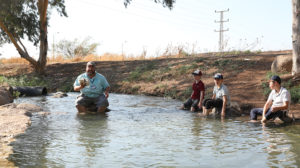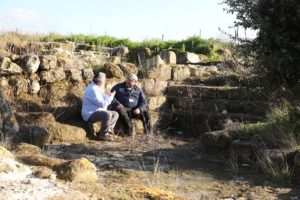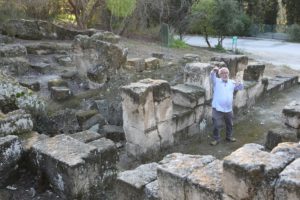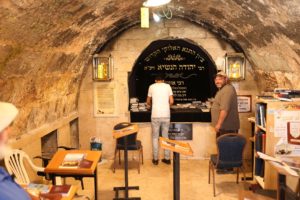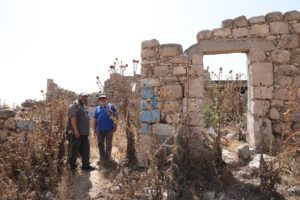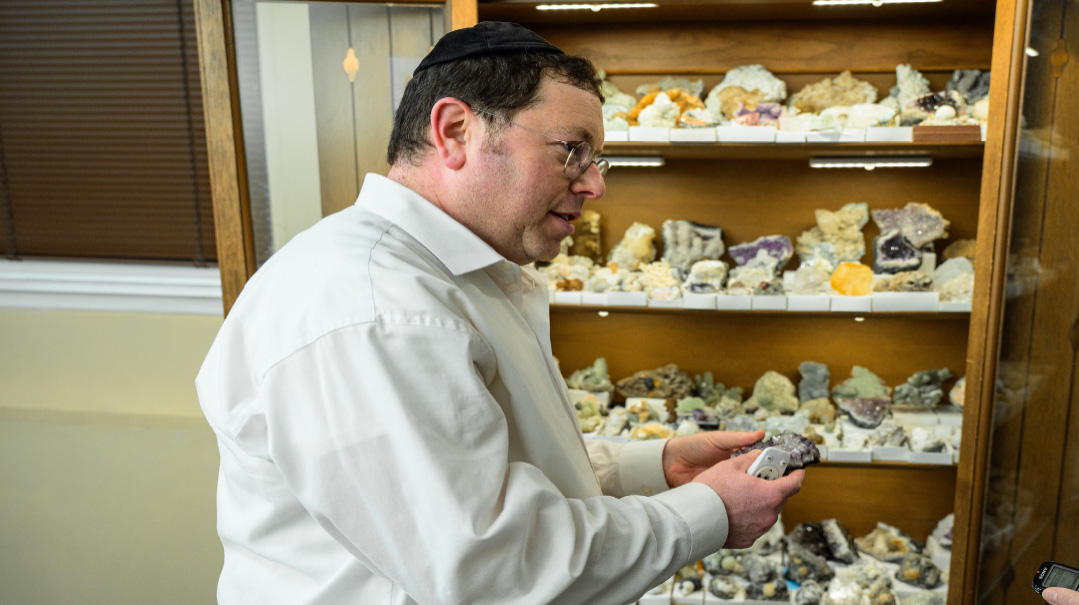Sanhedrin Stopovers
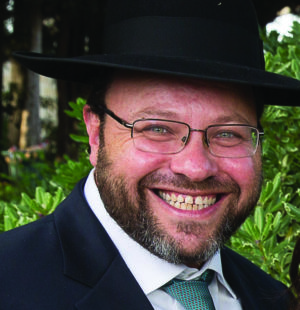
The Shvil HaSanhedrin is the brainchild of veteran archaeologist and guide Dr. Chagi Amitzur
Video: Gil Mezuman
Hike to a Higher Place
If Minnesota is the Land of 10,000 Lakes, Rwanda is the Country of a Thousand Hills, and if Boro Park is the Zone of 100 Pizza Shops, Eretz Yisrael is the Land of 5,000 Trails.
While there are amazing places to see all over the world, only in Eretz Yisrael does one get a mitzvah for every four amos one walks (which I try to remind kvetchy tourists about if a hike seems too long). There are trails for all types of hikers: There’s the Shvil Yisrael, a 1,000-kilometer north-south hike from Tel Dan to Eilat, and the shorter west-east Yam L’Yam trail from the Mediterranean Sea to the Kinneret. There are bike, jeep, horse and even camel trails all over the country. Yet until recently a trail that could connect and educate Jews of all backgrounds was lacking. That changed in 2018 with the introduction of the Shvil HaSanhedrin, the brainchild of veteran archaeologist and guide Dr. Chagi Amitzur, with whom I was privileged to tour at least part of this incredible trail.
In addition to his doctorates, tour guide courses, schools he’s run and digs he’s participated in, Chagi is someone with comprehensive knowledge and appreciation of Chazal and Jewish scholarship through the generations, and is always passionate about making the connection between their holy words and the sites he visits. Chagi has always harbored a dream to create a trail that would not only be one that would fulfill the mitzvah of walking through the land, but would also fulfill the words of Bnei Brak posek Rav Mordechai Gross in his work Menuchas Emes:
It is desirous that on one’s tiyul in Eretz Yisrael one should learn the verses and sayings of our holy sages of the greatness and specialness of each portion of Eretz Yisrael one visits…. When one goes on a tiyul, and especially with one’s children, it is fitting to hike in places that are connected to the words of Chazal, such as places with antiquities and ancient vessels that are mentioned in the Mishnah and Gemara.
This was Chagi’s vision: to create a trail in the footsteps of the Sanhedrin in the Galilee that wouldn’t just be a nature hike in Israel’s most lush region, but one that would also have interactive sites and a strong human angle that would both teach and inspire. For 20 years, the plan languished in the great bureaucracy of the various related government bodies.
In 2015, things changed. Israel’s new Antiquities Authority director, Yisrael Chason, was not an archeologist, but a businessman and educator who wanted to make the Authority relevant to a new generation. He put out a call for new projects and Chagi’s Shvil HaSanhedrin was exactly what they were looking for.
The three-year project had a target date for Israel Independence Day 2018. It was meant to be a birthday gift for Israel’s 70 years of statehood, commemorating the 70 members of Sanhedrin. When the project was completed, it actually ended up being 120 kilometers, which is the number of members of the Anshei Knesses Hagedolah. We tour guides always know how to make things fit.
A Human Shield
Our tour begins on the outskirts of the Arab city of Shefaram at the kever of Rabi Yehudah Ben Bava. Personally, I’m not one of those tour guides that likes to venture into Arab villages, and I don’t carry a gun. (I figure if we need to count on my marksmanship to protect us we’re already in trouble.) But Chagi assures me that Shefaram is one of the safest Arab villages I’d ever encounter. Before the War of Independence, Shefaram was a mixed city of Muslims, Christians and Druze, and during the war, the Arab Liberation Army that consisted of many Druze who were based in the town signed a truce; many even joined the IDF, becoming its first Arabic- speaking force. Until today you can see Israeli flags hanging throughout the city.
We’ve chosen to start our tour from the kever of Rabi Yehudah ben Bava, as the story of the arrival of the Sanhedrin to the North can best depicted here. The Gemara tells us that after the Bar Kochva revolt, the execution of Rabi Akiva, and the death of his 24,000 students, Rabi Yehudah took Rabi Akiva’s five remaining talmidim, gave them semichah and reestablished them as members of the Sanhedrin, moving from Yavneh in the south to Usha in the north.
The next generation — led by Rabi Yehudah Bar Ilai, Rabi Meir, Rabi Yosi, Rabi Nechemia, and Rabi Shimon Bar Yochai — got their start right here by the kever of Rabi Yehudah ben Bava, who charged them with his last holy mission before being murdered by the Romans, using his body as a shield as they fled. It is the mesirus nefesh for Torah that they carried with them and passed down to their talmidim that set the foundation for the Torah that has endured until today.
Now, whenever skeptical tourists ask, “How do we know that he’s really buried here?” the knee-jerk response is that we have a tradition from the Arizal, who in the 1500s identified the majority of the kevarim that we know of today. Yet the kever of Rabi Yehudah ben Bava is one of the few kevarim that didn’t require any subsequent kabbalistic corroboration. It’s unique in that the city of Shefaram is one of the only places in Eretz Yisrael that had consistent Jewish life and community from the times of the Churban until the 1920s, when the remaining Jews left the city.
In addition, the Gemara (Sanhedrin 14a) describes for us precisely where he was killed:
One time the wicked kingdom issued decrees against the Jews. They said that anyone who gives or receives semichah will be killed, the city in which it is given will be destroyed, and the signs that identify the boundaries of the city (the techumim of Shabbos) will be uprooted. What did Rabi Yehudah Ben Bava do? He went and sat between two large mountains, between two large cities, and between two techumei Shabbos boundaries — Usha and Shefaram — and gave semichah to the five zekeinim.
Rabi Yehudah thought he would be safe here, and that even if he got caught, the cities would avoid culpability and destruction. Yet it was here that the Romans caught him and “pierced him with 300 spears like a sieve.” The Gemara further tells us that someone who is killed al kiddush Hashem is buried where he is killed.
We look around this humble ohel of his kever (it’s currently under reconstruction) and see the hill town of Usha, on our right, and the ancient city of Shefaram, on our left. Then Chagi pulls his ace out of the deck. He takes us to a chiseled stone that was discovered about three-quarters of a mile from Usha, directly equidistant from Shefaram, that says the word Shabbos on it. This was the techum stone that the Gemara was talking about! One stone marked 2,000 mil distance from Usha — the techum Shabbos — and another stone marked the techum from Shefaram. It really doesn’t get much more exact than that.
Visiting kivrei tzaddikim is more than just an archaeological excursion. When we share their stories, their inspiration serves as a merit for our tefillos. In fact, Rabi Yehudah ben Bava is the master of the chassidishe story — any time the Gemara tells us a story about an anonymous chassid, it’s referring to Rabi Yehudah ben Bava, and his life reads like a true gedolim biography. According to the Midrash, from the age of 18 he never slept more than 60 breaths; he fasted for 26 years; he never erred in halachah; there was never anyone that met him who wasn’t enlightened by his Torah. Yet his humility overshadowed his greatness — he referred to each of his students as “Rebbi.” He saw in each of them the ability to become teachers and links in the chain in the Torah’s transmission, and he gave them the confidence to become the leaders of the next generation. His teaching was infused with kindness, inspiration, and the ability to lift up his talmidim. He was the quintessential chassidishe rebbe.
Laws for Survival
We now head over to the recently excavated site of Usha, where we meet the lead archeologist at the site, Chagi’s son Yair. This was the first stop of the Sanhedrin in their migration to the north of Israel, and Jews continued to live here until the time of the Amoraim in the fourth century C.E. As with many ancient towns, the name and location of this city was preserved by the name of the Arab village that was right next to it, called Hosha. Yet when the village was rebuilt about 150 years ago, the local Arabs didn’t resettle the top of the hill despite its strategic location and numerous water cisterns; rather, they took the chiseled rocks of the ancient houses and rebuilt their structures on the lower half of the hill. When Yair interviewed some of the older Arab women of the former village, they told him that the top of the hill was a “mazar — the Arabic word for holy place — and they were forbidden to build there because of the spirits.
Why did the Sanhedrin set themselves up here, I ask Chagi? Not the most yeshivish question, I know, but Chagi gives a typical tour-guide answer: He points out that in the distance we can see the Mediterranean Sea, Mt. Carmel, Haifa, and neighboring cities all the way to Acco. This is the edge of the border of Eretz Yisrael in Mishnaic times. The coastline was referred to as “eretz ha’amim” — the non-Jewish areas of Israel, and after the Bar Kochva revolt, the Jews looked for an out-of-the-way discreet place from where to rebuild. It is estimated there were 500 families that lived here in the times of the Sanhedrin. As Jewish influence grew and relations with the Romans improved, the Jews, and the Sanhedrin, moved eastward toward more central and larger locations, until ultimately landing in Teveria.
Usha, for its part, is perhaps most famous for the great takanos made there. When we learn them in Gemara, we might not pay much attention to the historical context of the takanos, but here, as we stand on the shvil of the Sanhedrin, we pause and appreciate them, imagining the great Torah leaders discussing them inside the remains of a large complex on the highest point of the hill, which was probably either the moshav haSanhedrin or the central beis knesses for the community. Yair explains to us that unlike other archeological sites where one has to extensively dig to find artifacts, over here, with just a few scoops of the shovel, they had already reached the ground level of this incredible study hall.
As we sit on the benches outside the remains of the structure, we note that the various takanos established here were really the keys to the survival and continuity of the nation. Living in such close proximity to the gentiles on the coastline, various takanos were established that declared the vessels of the eretz ha’amim were impure. The Sages, fearing assimilation, wanted the Jews to live together. By establishing new takanos of impurity, they were able to keep the people together and connected, with the hope and belief that one day the rituals of the Holy Temple would be reinstituted.
Other takanos involved the maximum amount permitted for redeeming captives, restriction on the amount individuals were permitted to give away to charity, the establishment of communal soup kitchens and charity funds, and laws about supporting elderly parents and young children. The takanos were all part of recreating a healthy and strong family unit, one that would not look to the gentiles and to humiliating ways to support their families, but that would create incentives to rebuild their communities.
One of the last dramatic takanos that took place here was reestablishing the centrality of Eretz Yisrael and the Sanhedrin regarding the fixing of the months and holidays, endangered by those who had started creating their own systems in Bavel and other places in chutz l’Aretz. Despite the larger and perhaps even more scholarly communities in Bavel, Eretz Yisrael would be fixed as the central place from where Torah would emerge.
Uncontaminated
We now head down the excavated ancient street and market. The first room we approach has an ancient olive press, yet this one is unique. Chagi shows me how the storage room and the olive-press room are designed with a wall that does not allow access from one to the other. At first glance, that doesn’t seem like good planning, as one would have to exit into the corridor in order to go into the other room. But the reason for this construction is given away by the remains of the mikveh here in the hallway. It was designed this way so that in case someone became tamei while pressing the oil, he wouldn’t contaminate the storage room by walking through it — he would toivel in the mikveh first. These rather extreme safeguards were discovered in three other olive and wine presses, and are a testimony to the status Chazal tell us regarding the “chaveirim” of Usha who, even after the Churban, were strict about eating chulin (unconsecrated produce) in purity.
The Talmud in Eiruvin tells us that the Tanna Rabi Yitzchak Nafcha (not to be confused with his descendant, an Amora of the same name) had five courtyards in Usha. Often the last name of a Tanna reveals his occupation, and there is a question whether Nafcha is a reference to his being a glassblower or a blacksmith. Do any of the archeological finds here shed a light on this question? Well, at first, Chagi tells me, they were very excited to find glass-making workshops and ovens, which might have solved the riddle. And being so close to the coast made it opportune to bring in the sand from the beach to make glass. But then they discovered a blacksmith’s cauldron along with metal tools presumably made there. And so, with both industries active here, the guild Rabi Yitzchak Nafcha was part of remains a mystery.
Hi, Are You Jewish?
Leaving Usha, we backtrack from where we started and now enter the city of Shefaram. This is no archeological site, but a bustling Arab metropolis of close to 40,000 residents. It’s hard to imagine Jews living here, let alone picture the Sanhedrin. Yet fascinatingly enough, after winding down quite a few tiny alleyways and around the corner from a mosque and a church, we find ourselves standing in front of a shul building with a menorah atop it. This shul, which was built in the 1700s on the ruins of an earlier shul, is where, as tradition has it, the Sanhedrin once sat.
Throughout the Roman and Byzantine periods, and even in the Muslim and Crusader eras, Shefaram had a flourishing Jewish community. In the 1500s the famed Portuguese philanthropist Donna Gracia Mendes Nasi purchased Shefaram together with four other villages, plus the city of Teveria from the Ottoman Empire, in order to rebuild Jewish life in Israel in what many consider to be the first political and diplomatic attempted return of the Jews to Eretz Yisrael.
The key to the shul is guarded by an Arab family across the street, who have kept it in their family for generations, and believe it brings them blessing and protection. They are delighted to give it to us, and even offer us some Middle Eastern hospitality (that we thank them for but politely turn down). A surprising recent study of Arab families in the area indicated that many of them, in fact, have Jewish roots. In pre-state Eretz Yisrael, there were many Jewish families who lived assimilated lives in Arab towns, and some of those families still have Jewish names and customs. Perhaps it’s the possibility of old Jewish blood flowing in some of the locals’ veins that makes this city so protective of its ancient Jewish shrines.
I get chills as we enter the shul, which had minyanim daily for close to three hundred years, until the 1920s. As it’s located right off the road for those traveling from the coastline to Teveria or up to Tzfat, there are numerous testimonies of gedolim over the centuries who stopped here and davened. Rav Moshe Cordovero, the Arizal, and the Ohr Hachaim Hakadosh are just a few of those who davened in the original shul building, while in the 1700s, Rav Chaim Abulafia — who was invited by the Ottaman ruler Dahr El Ohmar to rebuild the city of Teveria — stopped here and assisted in building the current shul. Rav Yisrael Mi’Shklov, a talmid of the Vilna Gaon in the late 1700s, wrote of how he buried his wife in the ancient cemetery adjoining the shul (which Chagi was instrumental in reopening for visitors).
The Zzz’s Have It
For the next part of our trek on the Sanhedrin Shvil, we decided to experience some of the incredible nature and beauty that our ancestors appreciated so much about this area, with a drive down to Nachal Tzippori on the way to Beit Shearim. Tzippori and Beit Shearim were the next stops of the Sanhedrin. It was in those more central cities that Rabi Yehudah Hanasi — who was born in Usha — lived and wrote much of the Mishnah.
This season is the nicest time of year to visit Israel’s nature sites, as everything is green from the blessed winter rains we experienced this past year. We pass grazing cows and sheep, imagining the local shepherds to be our ancestors whose flocks grazed on these very hills. We arrive at a beautifully crafted new bridge and walkway that was recently constructed for the Shvil HaSanhedrin, and the rushing waters of Nachal Tzippori are a great place for us to soak our feet and enjoy lunch.
In the distance Chagi points out Churbat Sasi on top of the hill. The Talmud questions whether this village, originally called Kfar Sisai, was included in the borders of Eretz Yisrael. I had always assumed that the settlement of Sasa, near Meron in the upper Galilee, was the city in question, and in fact Wikipedia even claims that. Well, Wikipedia never took Chagi’s tour or cracked that Gemara in Gittin which clearly states that the town is located close to Tzippori, which is nowhere near Sasa.
The city was perhaps most famous for its prodigy son, Levi bar Sisi, a disciple of Rabi Yehudah Hanasi. Rebbi gave his personal recommendation to Levi to become the spiritual leader of a neighboring community called Simoniya — today Tel Shimron. It seems the plan didn’t work out in the long run, though, because after Rebbi’s death, Levi Bar Sisi moved to Bavel to learn with Abba bar Abba, but he wasn’t forgotten — in fact, we still remember him every single day. Levi is noted for issuing the enduring directive that when we recite the words “l’ma’an tizkeru” in the third paragraph of Shema, we should be careful to emphasize the zayin in tizkeru so it doesn’t sound like a samach, which would indicate “reward” instead of “remember.”
Surprise Ending
Although we hadn’t planned on stopping the tour at this point, Hashem had His plans for us, and taught us a lesson too: Never take a Honda Civic down a gravel road near a riverbed full of sharp rocks. Not only did we get a flat tire, but none of the local farmers or other cars that saw our predicament could help us get it off. So we drove into the nearby Arab village of Ras Ali where we were told there was a local mechanic. It turns out his shop was in his backyard, and he was out doing some shopping, so his wife, mother, grandmother and children offered us some coffee that we politely thanked them for (but didn’t drink). We waited until Samir came home, and after giving the wheel a few good zetzes, changed our tire.
It might not have been the perfect ending to an amazing day. But it reminded me of the Gemara about how Levi bar Sisi also didn’t get to his desired destination. After Levi died, it was revealed that he wasn’t allowed into Gan Eden because he left Eretz Yisrael and didn’t remain in the yeshivah of Rebbi. It was only the merit and greatness of Shmuel, the son of Abba bar Abba, who was able to bring him all the way in.
The Sanhedrin, too, spent many years moving through the Galilee until it reached its final port in Teveria. It is from there, we are told, that they will be reestablished once again. G-d willing, we’ll all be there for the inauguration.
(Originally featured in Mishpacha, Issue 856)
Oops! We could not locate your form.


